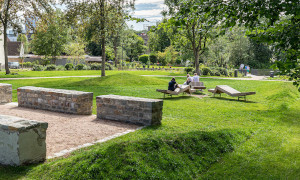No matter what the causes, whether overused, littered or neglected - open spaces that are unkempt have a negative effect in several ways: their condition provides direct information about their value and importance in the urban fabric.
Mostly according to the simple formula: The wealthier the residents or the more prestigious or closer to city center/government seat, the better in shape. Is this compatible with equal living conditions and environmental justice?
Lack of care and maintenance directly reduces the structural and plant substance of open spaces. Wear and tear and ageing processes that are not counteracted cause a serious reduction in value and thus the loss of well-payable, usually public investments. The neglected open spaces usually lose considerably in aesthetic, social and ecological quality and function.
Despite this, cities continue to receive generous state support for the investment costs incurred in the construction and planning of open spaces. As things stand, the corresponding funding programmes and their number have never been so high. In the BMI press release of July 2018, Minister Horst Seehofer is quoted as saying, "Our common goal is for everyone to feel at home in their city or town, to enjoy living in their neighborhood. The Federal Government is supporting the Länder and municipalities this year with federal financial assistance of almost 1 billion euros. We are continuing the successful urban development funding programs at record levels."
This is a good indication of the decision at the political level to invest a great deal of money in liveable cities by creating high-quality public open spaces. It is astonishing that their sustainable maintenance is not part of this objective. Often the destruction of value through inadequate maintenance begins immediately after completion - this can hardly be thought through to its logical conclusion. . .
It seems to be difficult in practice to make the connection between the costs and benefits of maintenance. In the case of hard, grey infrastructure it is immediately obvious - but apparently not in the case of green infrastructure. It grows by itself?
In 2018, the Urban and Open Space Planning Working Group invited various experts to learn about strategies and possible courses of action, to ask questions and to discuss. What can be done about the loss of value and investment due to poor maintenance? What are the strategies for effective maintenance when budgets are too tight? Is it right to assess care costs on a sliding scale? Can a handbook on good maintenance help, such as the one recently produced by the Berlin Senate Department? Is there still a need for a horticultural department like the one in Munich, which, with its master craftsmen and trainees, takes care of a large part of the care itself? And - how much of this dilemma do we landscape architects have to take into account already at the design stage? Are such issues also dealt with in teaching and research at colleges and universities?
We have not found a comprehensive solution to the problem. But various approaches for good arguments, measurable criteria and helpful basics can be read in this booklet "Good Conversation". Of course, the approaches cannot be directly transferred, but have to be examined before the respective context. Nevertheless, we hope that one or the other idea will be helpful in practice.
Author: Prof. Ulrike Böhm, landscape architect bdla, bbzl boehm benfer zahiri, Berlin, bdla spokesperson for urban development and open space planning. The text appeared in the bdla association magazine "Landschaftsarchitekten" 2/2019.
- Latitude: 0
- Longitude: 0


